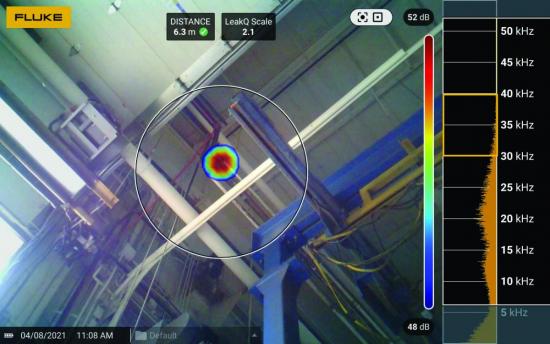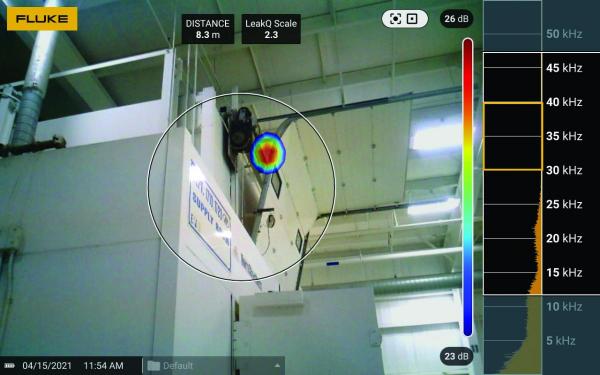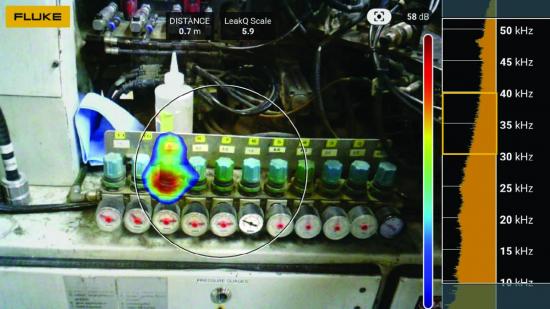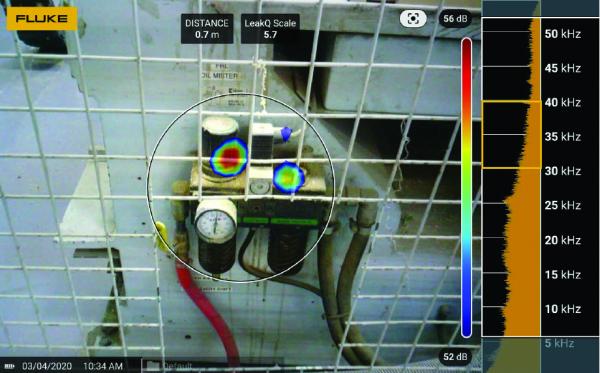Imagine what you could do if you were 30 feet taller! A newly developed style of leak detector can greatly extend your reach and help precisely locate and estimate hard to find leaks, even in the rafters of your plant. This article discusses some recent experiences in using an acoustical imaging leak detector.

Figure 1: This leak was detected in the ceiling 30 feet up. The operator was able to identify the leak was Argon costing \$24,000 per year in gas costs. (Source: Fluke ii900 Industrial Acoustic Imager).
Ultrasonic leak detector guns have long since been the best line of defense against compressed air waste. Studies have shown in the average plant about 25 percent of all the compressed air produced by the air compressors leaks out of the system piping before getting to the destination. In plants without leak management programs this number can reach astronomical level of 80 percent or higher.
One of the best ways to reduce compressed air costs is to look for ways to reduce leakage flow, an unnecessary load that is a constant demand on the compressed air system. This flow is never-ending and occurs during production periods, and during quiet times at night or on weekends. Reducing the flow in a well-controlled compressed air system will result in the reduction of compressor energy consumption, usually by about \$1,750 per every 10 cfm, and often reduces pressure loss, allowing your machines to run better.
Ultrasonic Leak Detection
Many people simply find leaks using the human ear. In quiet facilities, this exercise is guaranteed to result in good energy savings. But unfortunately, most industrial sites are very noisy, drowning out any hint of sound from audible compressed air waste. To be able to better detect gas leakage some sort of ultrasonic detector must be used. These detectors block ambient low frequency noise and help to amplify the telltale high frequency audible signal emitted by the expansion of gas from a pressurized source. These detectors also pick up signals from other ultrasonic emitters like cathode ray tubes, fan blades, pumps, vacuum pick-ups and other things, which can be problematic.
Typical ultrasonic devices are hand-held style that look like handguns. The trigger is pulled, enabling a directional microphone mounted on the front of the unit to connect with operator worn earphones. The detector is then directed in a sweeping motion towards various areas of the plant, and the leaks are detected by observing the change in amplified signal. The signal change, and the waving motion, will lead the operator in one direction or another, enabling them to find even the tiniest of leaks of a fraction of a cubic foot.
This type of directional detection is highly effective if you have good access to the leak locations. Typically, when a leak is found, the operator must feel around for the air leak by hand to detect the exact location on the component. This is problematic when the leak is, for example, near the roofline of a large industrial building some 30 or 40 feet up, or within a fenced off area behind safety barriers.
Technological Advance with Visual Acoustic Imagers
Recently there has been huge technological advances in leak detection. Sophisticated visual acoustic imagers have now been developed that overlay a digital picture of a sound pattern onto a video screen image taken with a video camera. These detectors use not one, but many directional microphones that all feed into a complex processing system. The microphones detect the exact position of the signal by triangulation is allows the operator to quickly pinpoint exact leak locations and distance from the detector. The decibel level of the signal is analyzed, and since the distance is known a good estimate of the leakage flow can automatically be calculated based on a calibration table. This type of detector can be extremely useful where common leakage points are not normally accessible, such as for piping run along the ceiling, or where pneumatic components are installed behind safety shields.

Figure 2: This hidden leak, located above a paint booth, behind a roll up door, was detected by an acoustic imager and had been missed by two earlier scans with a standard leak detector.
Acoustic imagers can find leaks not only in compressed air systems, but other systems like industrial gasses, vacuum, and steam. Many are also useful in detecting electric discharge caused by failing high-voltage electrical insulators.
Leak detector guns using one microphone have some usage challenges. Many auditors have found that leak detection in a working plant is difficult, especially if there are many compressed air uses running during production activities. During a recent audit, a sanding booth was encountered with a dozen or so tools being used to condition components. The air consumption of the compressed air powered hand tools swamped out any signal from leakage from connectors and hoses when a gun was used. However, when an acoustic imager was used these random compressed air demands were easily differentiated from constant demands consumed by leaks.
Reflections from leakage sources can be an issue with standard guns. Quite often, during an audit, the operator can be lead away in the wrong direction because a leak near a wall, or at the ceiling causes a reflection off another flat surface, causing a false signal. These false signals are again easily discounted when using a visual detector by moving the camera left and right and seeing how the image changes. If the point doesn’t change location on the screen, then it is likely a legitimate leak.

Figure 3: Leakage in complex pneumatic component block is very difficult to pinpoint with typical leak detector guns.
Finding Leaks in Hard-to-Reach Locations
And leakage in hard-to-reach spots such as piping running along the ceiling can be hard to identify with standard guns. Often the general direction of the leak can be detected but not the exact spot. This then requires the operator to find a way to reach 30 feet up to get a better location. Safety rules often prevent work at heights unless a carefully planning and setup is done, often requiring scaffolding to be erected, all the while there is a chance of a false signal negating the effort.
Recently, during a leakage audit at a large highway bus manufacturer using an acoustic imager, a leak in a mess of piping was detected at the ceiling levels above an entrance door. The leakage flow, automatically calculated by the acoustic imager using the distance and sound level, was estimated at only one cubic foot per minute, not a hugely significant cost if it was a compressed air leak. But since the detection showed the exact position of the leak the operator determined it was a leak in the Argon welding piping. Because the cost of Argon is about 230 times more than compressed air, and the leak flow was continuous, the leak calculated to an eyepopping \$24,000 per year in wasted gas.
This recent audit turned up similar finds in the compressed air, nitrogen, argon and CO2 systems. In all, after about two hours of visual scanning, the facility was found to have numerous precisely located leaks totaling about \$72,000 in annual costs proving it pays to detect and correct gas leaks.
Acoustic imagers are very good tools to assist in finding gas leaks faster and safer, and assessing the resulting flows more accurately.

Figure 4: Safety barriers sometimes require the production to be shut down to detect the exact position of the leak when using a standard gun.
About the Author
Ron Marshall is a compressed air auditor, technical writer, and trainer. For more information about this article, contact him at email: ronm@mts.net.
To read articles on Compressed Air Leak System Assessments, visit www.airbestpractices.com/system-assessments/leaks.
For expert presentations, visit our Webinar Archive Section dedicated to Compressed Air Measurement at www.airbestpractices.com/webinars.




